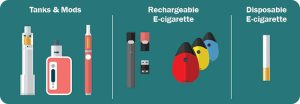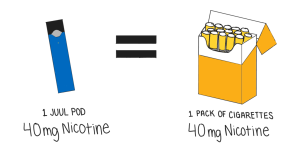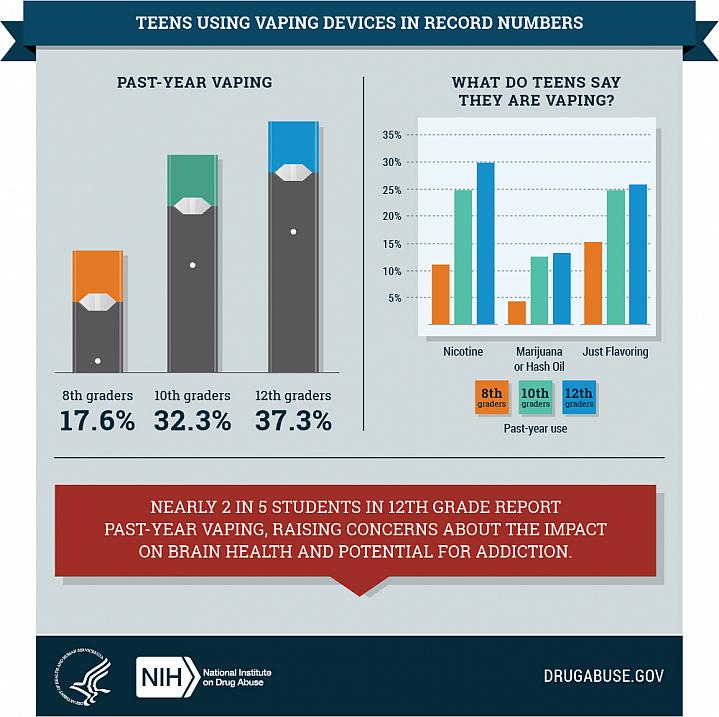13 Vaping Nicotine and the Developing Brain
Bella Huston
The History of Vaping
Tobacco and nicotine consumption has occurred for thousands of years. The many methods of nicotine use include smoking, chewing, sniffing, and most recently, vaping. The traditional cigarette was invented in the early 1800s, but its harmful effects weren’t discovered until the late 1940s (CDC, 2015). The realization of these negative effects motivated Chinese pharmacist Hon Lik to invent the e-cigarette as a safer, healthier alternative form of nicotine consumption. (Choucair, 2022).
The e-cigarette quickly became a non-medical method of quitting tobacco smoking, and advertising for the devices boomed (Choucair, 2022). This advertising caused many to believe, and still believe, that e-cigarettes are safer and better-tasting than cigarettes. While e-cigarettes can serve as a necessary stepping stone for people who want to quit smoking, e-cigarettes have also become a drug use practice of their own. Many young people use e-cigarettes but have never picked up a traditional cigarette.
The long-standing issue regarding the use of tobacco products among young people still exists today. The e-cigarette, although invented in 2003, did not become the most-used tobacco product among adolescents until 2014 (CDC, 2021a). Adolescent e-cigarette use has continued to grow since 2014. In 2019, 25.5% of 12th graders, 19.9% of 10th graders, and 9.6% of 8th graders reported vaping in the past 30 days (CDC, 2021b). The high rates of e-cigarette use among adolescents pushed the Food and Drug Administration (FDA) to implement anti-vape strategies in 2018. This ultimately led to an increase in the tobacco-product purchasing age from 18 to 21 in 2019 (Choucair, 2022).

Electronic e-cigarette devices, either disposable or rechargeable, heat a nicotine-containing liquid in order for the user to inhale the aerosol (CDC, 2022). This liquid contains high levels of nicotine, ultrafine metal particles, and potentially dangerous flavoring chemicals (CDC, 2022). Tanks and “mod” forms of e-cigarettes present unique risks because the composition of the liquid can be “modified” to contain a higher percentage of toxic chemicals. The batteries of these devices can also be replaced with stronger batteries that heat liquids to higher temperatures and produce more potent vapor (Laucks & Salzman, 2020). Rechargeable e-cigarettes often contain removable, flavored pods that contain more nicotine than a pack of cigarettes (Prochaska et al., 2021). E-cigarette technology is also found in the form of hookah and vape pens used to inhale THC (Choucair, 2022). To learn more about the effects of THC on the adolescent brain, visit this chapter.
Nicotine and the Brain

Research shows that adolescents may possess a higher risk for nicotine dependence due to their brain’s lack of maturity (Ferkol et al., 2018). Research on adolescent nicotine dependence through vaping remains limited. Still, the idea that nicotine from e-cigarettes causes addiction is supported by the fact that 90% of current cigarette smokers started smoking before they turned 18 (Ferkol et al., 2018). Frequent nicotine exposure affects the brain to a point where it needs the drug to function normally. If the nicotine use stops, it can cause withdrawal symptoms (Ferkol et al., 2018).
Nicotine affects the reward pathway of the brain by binding to neuron receptors and causing the release of dopamine (Herman & Tarran, 2020). Frequent exposure to nicotine can damage the receptors, leading to the cycle of craving that causes addiction (Herman & Tarran, 2020). The longer a person vapes nicotine products, the more nicotine receptors are created on neurons, and increasing the number of receptors increases the strength of cravings (Herman & Tarran, 2020). Quitting vaping may cause withdrawal symptoms because of the brain’s difficulty producing dopamine without nicotine (Herman & Tarran, 2020). When use stops, nicotine receptors slowly decrease, allowing brain structure to return to normal (Herman & Tarran, 2020). However, this process is more difficult for adolescent vapers because the reward pathway in the prefrontal cortex never fully developed before vape exposure (Goriounova & Mansvelder, 2012). Additionally, vape pods and vape liquids contain significantly more nicotine than a cigarette, contributing to a quicker onset of dependency compared to traditional cigarettes (Prochaska et al., 2021).
Other Cognitive Effects
Vaping increases levels of oxidative stress (Onojighofia, 2019). The developing brain of adolescents is more vulnerable to the effects of oxidative stress because of high oxygen consumption during development (Onojighofia, 2019). Research shows that oxidative stress contributes to sleep difficulty, cognitive impairments, aggressive behavior, difficulty paying attention, and mental health issues such as depression and suicide (Onojighofia, 2019).
Research on the long-term behavioral impacts of vaping continues to grow. The research shows that vaping can increase the risk of using other drugs throughout adulthood because nicotine increases brain sensitivity to other substances (Becker & Rice, 2021). Vaping can also affect short-term memory, and long-term inflammation caused by vaping may also impair memory functions (Prasedya et al., 2020).

The Role of Mental Health and Social Media
The rise in adolescent e-cigarette usage can be partly attributed to the increase in adolescent mental health disorders in the last ten years (Onojighofia, 2019). Mental health disorders have numerous negative implications on adolescents, including but not limited to poorer academic, social, and physical performance (Onojighofia, 2019). Adolescent vape use can also cause increased sensitivity to stress and negative emotions, which may contribute to mental health disorders even after vape use ends (Goriounova & Mansvelder, 2012).
Vape-normalizing content, peers who use vapes, and social media advertisements also contribute to adolescents’ use (Vogel et al., 2021). From 2019 to 2021, online time rose to over 5 hours for tweens and over 8 hours for teens (Moyer, 2022). This increased screen time increases exposure to vape content. Even brief exposure to influencers with vapes significantly increases adolescents’ chance of vaping (Vogel et al., 2021).
Conclusion
Throughout the 2010s, the e-cigarette industry boomed. By 2020, over 450 brands of rechargeable, disposable, or modified e-cigarettes were available (NIDA, 2020). Then in 2020, the FDA began regulating the sale of flavored vape cartridges marketed to minors and non-smokers (NIDA, 2020). As more dangerous effects of vaping emerge, the FDA should continue to regulate vape products to keep adolescents safe and healthy. In the US today, the sale of e-cigarettes to people under 21 is banned, and the FDA regulates every aspect of the creation, labeling, promotion, and sale of vapes (NIDA, 2020).
Vaping is a harmful behavior for adolescents. Nicotine addiction and other changes to the brain can result from adolescent vaping, and adolescents should learn about the effects that can occur. Social media and mental health contribute to the rise in adolescent vaping, and new legislation and information about the negative effects will hopefully lead to a decrease in adolescent vaping.
Review Questions
1. Why was the e-cigarette originally created?
a. A healthier alternative to cigarettes
b. To completely stop nicotine use
c. For flavored air inhalation
d. For young people to use
2. Vaping is more dangerous for _____ due to the developmental nature of the brain.
a. Adults
b. Adolescents
c. College students
d. Elderly
3. Which of the following is a way that adolescents are influenced to use e-cigarettes?
a. Advertisements
b. Social media
c. Friends
d. All of the above
References
Becker, T., & Rice, T. (2022). Youth vaping: a review and update on global epidemiology, physical and behavioral health risks, and clinical considerations. European Journal of Pediatrics, 181(2), 453–462. https://doi.org/10.1007/s00431-021-04220-x
Centers for Disease Control and Prevention. (2015, July 21). 2000 Surgeon General’s Report Highlights: Tobacco Timeline. https://www.cdc.gov/tobacco/sgr/2000/highlights/historical/index.htm#:~:text=Cigarettes%20were%20first%20introduced%20in,imposed%20on%20cigarettes%20in%201864.
Centers for Disease Control and Prevention. (2021a, September 30). Youth e-cigarette use remains serious public health concern amid COVID-19 pandemic. https://www.cdc.gov/media/releases/2021/p0930-e-cigarette.html
Centers for Disease Control and Prevention. (2021b). TableSubUseTn. Use of selected substances in the past 30 days among 12th graders, 10th graders, and 8th graders, by sex and race: United States, selected years 1980-2020. https://www.cdc.gov/nchs/data/hus/2020-2021/SubUseTn.pdf
Centers for Disease Control and Prevention. (2022, November 10). Quick facts on the risks of e-cigarettes for kids, teens, and young adults. https://www.cdc.gov/tobacco/basic_information/e-cigarettes/Quick-Facts-on-the-Risks-of-E-cigarettes-for-Kids-Teens-and-Young-Adults.html
Choucair, B. (2022, April 17). E-cigarette. Encyclopedia Britannica. https://www.britannica.com/topic/e-cigarette
Ferkol, T., Farber, H., La Grutta, S., Leone, F., Marshall, H., Neptune, E., Pisinger, C., Vanker, A., Wistozky, M., Zabert, G., & Schraufnagel, D. (2018). Electronic cigarette use in youths: a position statement of the forum of international respiratory societies. European Respiratory Journal, 51(5). https://doi.org/10.1183/13993003.00278-2018
Goriounova, N. A., & Mansvelder, H. D. (2012). Short- and long-term consequences of nicotine exposure during adolescence for prefrontal cortex neuronal network function. Cold Spring Harbor perspectives in medicine, 2(12), a012120. https://doi.org/10.1101/ cshperspect.a012120
Herman, M., & Tarran, R. (2020). E-cigarettes, Nicotine, the Lung and the Brain: Multi-level Cascading Pathophysiology. The Journal of physiology, 598(22), 5063–5071. https://doi.org/10.1113/JP278388
Laucks, P. & Salzman, G. (2020). The dangers of vaping. Missouri Medicine, 117(2), 159–164. https://www.ncbi.nlm.nih.gov/pmc/articles/PMC7144697/
Moyer, M. (2022, March 24). Kids as young as 8 are using social media more than ever, study finds. The New York Times. https://www.nytimes.com/2022/03/24/well/family/child-social-media-use.html
National Cancer Institute. (n.d.). Definition of snuff tobacco. https://www.cancer.gov/publications/dictionaries/cancer-terms/def/snuff-tobacco
National Institute on Drug Abuse. (2020, January). Vaping Devices (Electronic Cigarettes) DrugFacts. https://nida.nih.gov/publications/drugfacts/vaping-devices-electronic-cigarettes#:~:text=Other%20devices%2C%20such%20as%20those,are%20currently%20on%20the%20market.
Onojighofia, T. (2019). On the potential harmful effects of E-Cigarettes (EC) on the developing brain: The relationship between vaping-induced oxidative stress and adolescent/young adults social maladjustment. Journal of Adolescence, 76(1), 202-209. https://doi.org/10.1016/j.adolescence.2019.09.004
Prasedya, E.S., Ambana, Y., Martyasari, N.W.R., Aprizal, Y., Nurrijawati & Sunarpi. (2020). Short-term E-cigarette toxicity effects on brain cognitive memory functions and inflammatory responses in mice. Toxicological Research 36, 267–273. https://doi.org/10.1007/s43188-019-00031-3
Prochaska, J., Vogel, E., & Benowitz, N. (2021). Nicotine delivery and cigarette equivalents from vaping a JUULpod. Tobacco Control 31(1). https://doi.org/10.1136/tobaccocontrol-2020-056367
Vogel, E. A., Ramo, D. E., Rubinstein, M. L., Delucchi, K. L., Darrow, S. M., Costello, C., & Prochaska, J. J. (2021). Effects of Social Media on Adolescents’ Willingness and Intention to Use E-Cigarettes: An Experimental Investigation. Nicotine & Tobacco Research: official journal of the Society for Research on Nicotine and Tobacco, 23(4), 694–701. https://doi.org/10.1093/ntr/ntaa003
a poisonous alkaloid chemical found in tobacco products
tobacco use through cigarettes or pipes
tobacco specifically for chewing
the inhalation of tobacco or "snuff" through the nose (NCI, n.d.)
small, removable containers of vape liquid that fit into a specific, rechargeable vaping device
a long pipe used to heat tobacco or marijuana and cool the vapor for inhalation
the chemical within marijuana responsible for producing a high
physically needing a drug to function
often painful physical and psychological symptoms that follows the discontinuance of an addictive drug
part of the brain that uses dopamine to encourage certain behaviors
a brain neurotransmitter involved in the reward pathway
an intense, urgent, or abnormal desire or longing
a specific region in the front of the brain that plays a role in cognitive, emotional and behavioral functioning
something that is dependent or reliant on something else
a brain imbalance of reactive oxygen molecules and the antioxidants that get rid of them
diminishment or loss of function/activity of, relating to, being, or involving conscious intellectual activity (such as thinking, reasoning, or remembering)
a local response to cellular injury characterized by redness, swelling, heat, and pain
a person who is able to generate interest in something (such as a consumer product) by posting about it on social media
a removable container that holds vape liquid

